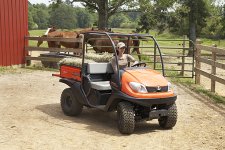Thank you. That was extremely helpful. :thumbsup:
Extremely incorrect.
I will add a bit to this discussion and speak in generalities since I do not know your vehicles capabilities. There are lots of functional options for the term 2WD and 4WD.
- Typically, 2WD actually means 1WD since the standard axle is an "open differential" that delivers most of the power to the wheel with the least traction. This is useful for turning with minimal tire scrubbing on hard surfaces and nice grassy areas as the inside and outside tires will turn at different speeds. Actual 2 driven wheels would involve either a single axle shaft with no differential, a locking differential for the axle or a limited slip type of differential clutch using springs or hydraulics (for example) under manual or computer control.
- 4WD can be a large misnomer also as it can simply be 2WD x 2- meaning it can have 2 wheels driving (1 front and 1 rear) or 3WD or true 4WD, depending upon equipment used. See 2WD options above. Typically a manually locked front differential can be a difficult handler and needs to be used very judiciously and at slow speeds.
- AWD on a modern vehicle is typically computer controlled and closet to a true 4WD system, depending upon how it is applied/controlled and will vary the amount of wheels driven depending upon feedback from the wheels to the computer. My Jeep is AWD.
My 2016 Polaris Ranger 900 XP has three switch selectable modes of operation: 1- open rear differential (standard 2WD with one wheel driving), 2- locked rear differential (real 2WD) and 3- AWD where the computer selects which of the 4 wheels to drive depending upon feedback (slippage/wheel spin) and how much power to supply each wheel. I usually use it in open rear axle (1WD) or AWD. In AWD I have pulled my wife's stuck 2000 Toyota Tacoma 2WD out of the sandy area it was mired in with nary a wheel spin from the Polaris. In locked 2WD it was spinning the rear wheels and not making any headway.
My 2015 RAM 2500 diesel can be 3WD with a locked rear differential in 4WD mode. I need to investigate further but recall seeing something somewhere about the front axle having the capability of being locked also; I do have a 4WD locked option on a switch and this may do it. Or maybe not.
My tractor in 4WD in actually only driving 1 front and 1 rear wheel. I can lock the rear differential to effectively get 3WD or unlock the brake pedal combining lever and with judicious use of the brake pedal on the spinning rear wheel get additional traction without using differential lock.
2wd means just that. BOTH wheels are driving.
One wheel spinning and one not does NOT mean its a one wheel drive.
An open differential means that BOTH wheels will apply the exact same amount of torque to the ground.
Hypothetically, lets say it takes 20 ft-lbs of torque to move the vehicle. IF one wheel is in the air, on ice, in mud, etc it takes very little torque to make it spin. Say 5 ft lbs of torque. With an open differential, that means that only 5ft lbs is being applied to the wheel that is in the air, on ice, in mud, etc and doesnt get you the required 20 ft-lbs needed to move the vehicle and you are stuck.
An open differential quite simply is EQUAL torque, UNEQUAL speed.
Where as a locker makes it UNEQUAL torque, EQUAL speed. So with a locker, while one wheel may only get 5ft lbs before it wants to spin, you can keep applying torque til the one with good traction starts a rolling. So...if the tire with good traction can get above the hypothetical 20 ft-lbs and still have grip, you will move.
Get so sick of ill informed people claiming that a 2wd is really a 1wd without a locker or LS, or hearing people claim their 4wd truck is really only a 2wd truck.
Open differentials have their place. They are good on ice because you are less likely to fishtail. And they are good on a road vehicle because you arent constantly scrubbing tires, getting wheel hop in turns, and are generally easier on the drive line.
Now how it relates to the RTV with basically 4 options
1. 2wd UNLOCKED....use this most frequently running around where traction isnt a prime concern
2. 4wd UNLOCKED ....USe this is its snowy, or soft, or when you otherwise need more traction that you dont think 2wd will do
3. 2wd LOCKED in.....Only use I can think is if you want to do some donuts in the snow/ice or in the mud
4. 4wd LOCKED in.....Use if 4wd unlocked fails you. This is a last resort before getting something to pull/winch you out

